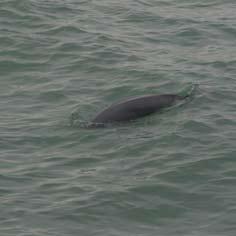
2 minute read
江豚在香港的歷史
24
江豚在香港的歷史 Their history in HK
Advertisement
Most people in Hong Kong are not aware of the existence of local finless porpoises. This general lack of awareness is mainly due to the porpoises’ cryptic behaviour at sea, which makes them extremely challenging to observe from a boat. In fact, there have been many records of stranded porpoises since the Agriculture, Fisheries and Conservation Department (AFCD) started to collate information on cetacean stranding events, but our understanding about them has been poor until fairly recently. In 1998, AFCD funded a comprehensive research study to investigate various aspects of population biology of finless porpoises in Hong Kong. As a result, our knowledge about the local porpoises has grown significantly in the past decade. The research on this mysterious sea creature in our waters is still on-going and what you are about to learn here are the fruitful results of this long-term study.

香港政府部門漁農自然護理署在多年來搜集江豚擱淺的資料

The Agriculture, Fisheries and Conservation Department of Hong Kong SAR Government has collected information from stranded finless porpoises for many years
在西貢清水灣天 后廟旁發現的一 個江豚頭骨
A finless porpoise skull found at a Tin Hau Temple near Clearwater Bay, Sai Kung
雖然香港人大多不認識江豚,但 本地漁民卻一直知道牠們的存 在。漁民不會視江豚如中華白 海豚般般神聖。如果不小心捉 到牠們的話,有些漁民更會吃掉 牠們﹗本地漁民一般稱呼江豚為 「海豬」,在海中遇見牠們時, 更親切地叫江豚作「豬仔」。有 些漁民透露,由於江豚有厚厚的 皮下脂肪,所以牠們的肉可給製 成臘肉。但當然,會這樣做的漁 民為數不多。漁民一般不會主動 捕捉江豚,即使不小心誤捕牠們 時,亦會快快地將屍體扔回海 中,以免招來惡運。研究員近年 亦在一些本地的天后廟發現江豚 的頭骨,所以有理由相信,雖然 漁民不會視江豚為神靈的化身, 但在傳統信仰上還是對牠們抱著 一點敬畏的。 25


Even though most people do not know anything about finless porpoises, fishermen have been observing them for generations. The fishermen do not regard finless porpoises as positively as the Chinese white dolphins, and some would even eat porpoises if they caught them. In fact, a nickname given to the finless porpoise by fishermen is “sea pig”, and when fishermen see porpoises, they will usually call them “little pigs”. Some fishermen have even mentioned that porpoise meat has been made into preserved meat, probably because of their oily blubber layer, but these fishermen are likely the minority. It is unlikely that fishermen hunt for porpoises deliberately, and most often they will just discard porpoises that have been caught incidentally back into the sea. It is also interesting to note that even though most fishermen do not consider the finless porpoise as a sacred creature, like the Chinese white dolphin, the skulls of porpoises were occasionally brought back to Tin Hau Temple in Hong Kong, probably for religious purpose.



